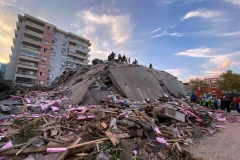
FACULTY OF ENGINEERING
Department of Civil Engineering
GEHU 207 | Course Introduction and Application Information
| Course Name |
Turkish Cuisine Culture
|
|
Code
|
Semester
|
Theory
(hour/week) |
Application/Lab
(hour/week) |
Local Credits
|
ECTS
|
|
GEHU 207
|
Fall/Spring
|
3
|
0
|
3
|
6
|
| Prerequisites |
None
|
|||||
| Course Language |
English
|
|||||
| Course Type |
Service Course
|
|||||
| Course Level |
First Cycle
|
|||||
| Mode of Delivery | - | |||||
| Teaching Methods and Techniques of the Course | - | |||||
| Course Coordinator | - | |||||
| Course Lecturer(s) | - | |||||
| Assistant(s) | - | |||||
| Course Objectives | The aim of the course is to describe, Turkish food culture under the influence of Anatolian historical heritage in the context of historical, archaeological and intangible cultural heritage and to apply them in their academic and professional lives. |
| Learning Outcomes |
The students who succeeded in this course;
|
| Course Description | This course describes and contains the Turkish cuisine culture, which is a synthesis, formed of historical, economic, political and social dynamics will develop students’ cultural awareness and professional vision and will prepare the ground for them to present their expertise in professional platforms in a more conscious and well-equipped manner. |
|
|
Core Courses | |
| Major Area Courses | ||
| Supportive Courses | ||
| Media and Management Skills Courses | ||
| Transferable Skill Courses |
WEEKLY SUBJECTS AND RELATED PREPARATION STUDIES
| Week | Subjects | Related Preparation |
| 1 | Introduction | |
| 2 | Paleolithic, Neolithic and Bronze Age Culinary Traditions in Anatolia | Homeros, Odysseia, Azra Erhat-A.Kadir (çev.), Dünya Klasikleri, Can Sanat Yayınları, 2008 |
| 3 | Archaic, Hellenistik and Roman Periods’ Cuisine Culture in Anatolia | Dalby A.-Graigner S. Antik Çağ Yemekleri ve Yemek Kültürü, Homer Kitabevi, 2001 Kimberly B. Flint-Hamilton, “Legumes in Ancient Greece and Rome: Food, Medicine, or Poison?”, Hesperia: The Journal of the American School of Classical Studies at Athens, Vol. 68, No.3 (Jul. - Sep., 1999), pp. 371-385, American School of Classical Studies at Athens, Wim Van Neer a,b, *, S. Thomas First archaeozoological evidence for haimation, the ‘invisible’ garum Parker Journal of Archaeological Science 35 (2008) |
| 4 | Byzantine Cuisine Culture | Andrew Dalby. Tastes of Byzantium: The Cuisine of a Legendary Empire. I. B. Tauris, London, 2010. Feast Fast or Famine, Food and Drink in Byzantium, Mayer W. and Trzcionka (eds.), 2017, Brill. |
| 5 | Cuisine Culture in Central Asian Turks before and after Islam | Sami Kılıç Ali Albayrak İslamiyetten Önce Türklerde Yiyecek Ve İçecekler Turkish Studies - International Periodical For The Languages, Literature And History Of Turkish Or Turkic Volume 7/2 Spring 2012, P.707-716 Ankara Güler, S. (2010). “Türk Mutfak Kültürü ve Yeme İçme Alışkanlıkları”, Dumlupınar Üniversitesi Sosyal Bilimler Dergisi, 26, s.26-63. Yemek Kitabı Tarih-Halkbilimi-Edebiyat M. Sabri Koz (der.), 2008 Üstün, Y., 2009, Eski Bir Türk İçeceği: Kımız (Koumiss) . Türklük Bilimi Araştırmaları , (26) , 247-255.. |
| 6 | First Appearance of Turks in Anatolia, Seljuks and Principates’ Cuisine Culture | Akin, G., Özkoçak, V., Gültekin T., 2017, Geçmişten Günümüze Geleneksel Anadolu Mutfak Kültürünün Gelişimi, Geçmişten Günümüze Geleneksel Anadolu Mutfak Kültürünün Gelişimi Konferans Sunumu., |
| 7 | Ottoman Period Cuisine Culture | 7 Ottoman Period Cuisine Culture “Ottoman Palace Cuisine of the Classical Period” (eds.) Özge Samancı, Arif Bilgin, inside Turkish Cuisine, Ankara, Kültür ve Turizm Bakanlığı Yayınları, 2008 s. 71-91. Arif Bilgin Saraydan Düğüne Fatih Dönemi Sofraları, Fatih Sultan Mehmed Han ve Dönemi, Dr. Ayşe Bilge Zafer (ed.), Bursa Osmangazi Belediyesi Yayınları, 2016.Işın P.M., 2014 Bountiful Empire, A History of Ottoman Cuisine |
| 8 | Midterm | |
| 9 | Ottoman Period Cuisine Culture | Özge Samancı Geç Dönem Osmanlı Saray Mutfak Kültüründe Ziyafetler Ve Yemekler Osmanlı’da Mimari, Sanat Ve Yemek Kültürü Editörler: Mükerrem Bedizel Zülfkar-Aydın & Ravza Aydın, Osmanlı’da Mimari, Sanat Ve Yemek Kültürü Editörler: Mükerrem Bedizel Zülfkar-Aydın & Ravza Aydın, 2018 |
| 10 | Republican Period Turkish Cuisine Culture | https://encyclopedia.1914-1918-online.net/article/post-war_economies_turkey Özge Samancı Images, perceptions and authenticity in Ottoman-Turkish cuisine, in Food Heritage and Nationalism in Europe, Ilaria Porciani (ed.),2019, Routledge Publication, Part II, 155-171. Güler, S. (2010). “Türk Mutfak Kültürü ve Yeme İçme Alışkanlıkları”, Dumlupınar Üniversitesi Sosyal Bilimler Dergisi, 26, s.26-63. |
| 11 | Turkish Cuisine Culture and New Trends - I | Defne Karaosmanoğlu, “Surviving the Global Market”, Food, Culture & Society, Vol. 10 , Iss. 3, 2007, 425-448. Yemek Kitabı Tarih-Halkbilimi-Edebiyat M. Sabri Koz (der.), 2008 |
| 12 | Presentation | |
| 13 | Presentation | |
| 14 | Presentation | |
| 15 | Review of the semester | |
| 16 | Final Exam |
| Course Notes/Textbooks | Linda Civitello, Cuisine and Culture: A History of Food and People, 3rd edition, Wiley Publishers, 2011. |
| Suggested Readings/Materials | A Taste of Thyme: Culinary Cultures of the Middle East, Sami Zubaida and Richard Tapper (eds.) 1994, ISBN 1860646034
Wheats Facts and Futures 2009, (eds) Dixon, et. Al., Mexico: CIMMYT, 2009, ISBN 978-970-648-170-2
Royal Taste, Food, Power and Status at the European Courts after 1789, Asghate 2011, ISBN 9780754694786
Encounters with Europe, 1850-1950, (eds) Anna Frangoudaki, Çağşar Keyder, London: I.B. Tauris,2007, ISBN 9781845112899 |
EVALUATION SYSTEM
| Semester Activities | Number | Weigthing |
| Participation |
1
|
10
|
| Laboratory / Application | ||
| Field Work | ||
| Quizzes / Studio Critiques | ||
| Portfolio | ||
| Homework / Assignments |
1
|
10
|
| Presentation / Jury |
1
|
10
|
| Project |
1
|
10
|
| Seminar / Workshop | ||
| Oral Exams | ||
| Midterm |
1
|
20
|
| Final Exam |
1
|
40
|
| Total |
| Weighting of Semester Activities on the Final Grade |
5
|
60
|
| Weighting of End-of-Semester Activities on the Final Grade |
1
|
40
|
| Total |
ECTS / WORKLOAD TABLE
| Semester Activities | Number | Duration (Hours) | Workload |
|---|---|---|---|
| Theoretical Course Hours (Including exam week: 16 x total hours) |
16
|
3
|
48
|
| Laboratory / Application Hours (Including exam week: '.16.' x total hours) |
16
|
0
|
|
| Study Hours Out of Class |
14
|
2
|
28
|
| Field Work |
0
|
||
| Quizzes / Studio Critiques |
0
|
||
| Portfolio |
0
|
||
| Homework / Assignments |
1
|
15
|
15
|
| Presentation / Jury |
1
|
7
|
7
|
| Project |
1
|
20
|
20
|
| Seminar / Workshop |
0
|
||
| Oral Exam |
0
|
||
| Midterms |
1
|
20
|
20
|
| Final Exam |
1
|
30
|
30
|
| Total |
168
|
COURSE LEARNING OUTCOMES AND PROGRAM QUALIFICATIONS RELATIONSHIP
|
#
|
Program Competencies/Outcomes |
* Contribution Level
|
||||
|
1
|
2
|
3
|
4
|
5
|
||
| 1 | To have adequate knowledge in Mathematics, Science and Civil Engineering; to be able to use theoretical and applied information in these areas on complex engineering problems. |
|||||
| 2 | To be able to identify, define, formulate, and solve complex Civil Engineering problems; to be able to select and apply proper analysis and modeling methods for this purpose. |
|||||
| 3 | To be able to design a complex system, process, device or product under realistic constraints and conditions, in such a way as to meet the requirements; to be able to apply modern design methods for this purpose. |
|||||
| 4 | To be able to devise, select, and use modern techniques and tools needed for analysis and solution of complex problems in engineering applications. |
|||||
| 5 | To be able to design and conduct experiments, gather data, analyze and interpret results for investigating complex engineering problems or Civil Engineering research topics. |
|||||
| 6 | To be able to work efficiently in Civil Engineering disciplinary and multi-disciplinary teams; to be able to work individually. |
|||||
| 7 | To be able to communicate effectively in Turkish, both orally and in writing; to be able to author and comprehend written reports, to be able to prepare design and implementation reports, to present effectively, to be able to give and receive clear and comprehensible instructions. |
|||||
| 8 | To have knowledge about global and social impact of engineering practices on health, environment, and safety; to have knowledge about contemporary issues as they pertain to engineering; to be aware of the legal ramifications of engineering solutions. |
|||||
| 9 | To be aware of ethical behavior, professional and ethical responsibility; to have knowledge about standards utilized in engineering applications. |
|||||
| 10 | To have knowledge about industrial practices such as project management, risk management, and change management; to have awareness of entrepreneurship and innovation; to have knowledge about sustainable development. |
|||||
| 11 | To be able to collect data in the area of Civil Engineering, and to be able to communicate with colleagues in a foreign language; |
|||||
| 12 | To be able to speak a second foreign language at a medium level of fluency efficiently. |
|||||
| 13 | To recognize the need for lifelong learning; to be able to access information, to be able to stay current with developments in science and technology; to be able to relate the knowledge accumulated throughout the human history to Civil Engineering. |
|||||
*1 Lowest, 2 Low, 3 Average, 4 High, 5 Highest
NEWS |ALL NEWS
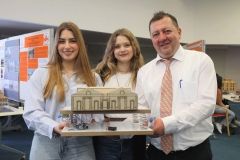
They examined building, showcased their models
Izmir University of Economics (IUE) Department of Civil Engineering and Architecture students examined 58 buildings in Izmir in terms of earthquake resistance
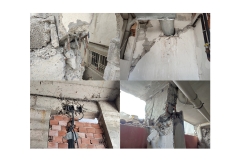
Photos of neglect
Asst. Prof. Dr. Egemen Sönmez, Lecturer at Department of Civil Engineering, Izmir University of Economics (IUE), went to the earthquake zone with

Exterior additions on buildings: cause for concern
Prof. Dr. Celalettin Kozanoğlu, Head of Department of Civil Engineering, Izmir University of Economics (IUE), warned about the water tanks placed on
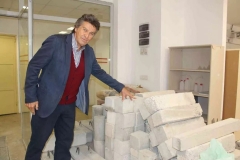
We should take advantage of industrial building technology
Building tests and urban transformation works gained momentum throughout Turkey after the earthquake disaster, the epicenter of which was Kahramanmaraş and killed

Vital warnings in building inspections
After the earthquake disaster, the epicenter of which was Kahramanmaraş and which caused destruction in 10 cities, thousands of citizens rushed to
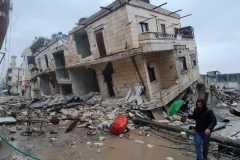
Negligence, not the soil, demolishes
Prof. Dr. Celalettin Kozanoğlu, Head of Department of Civil Engineering, Izmir University of Economics (IUE), stated that many buildings that were destroyed
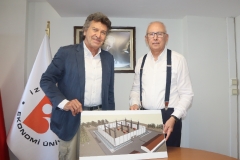
‘Firewall’ project
IUE Rector Prof. Dr. Murat Aşkar and Head of Department of Civil Engineering, Prof. Dr. Celalettin Kozanoğlu developed the ‘firewall’ project, which

